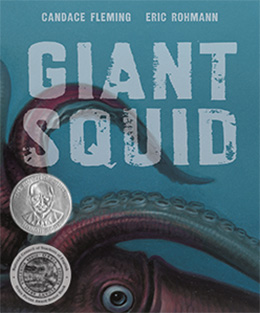BOOKS

illustrated by Eric Rohmann
Roaring Brook Press /
Macmillan , 2016
978–1596435995
ages 6 and up
buy the book
hardcover
After you’ve read Giant Squid, try this book:
Giant Squid
The giant squid is one of the most elusive creatures in the world. As large as whales, they hide beyond reach deep within the sea, forcing scientists to piece together their story from those clues they leave behind.
An injured whale’s ring-shaped scars indicate an encounter with a giant squid. A piece of beak broken off in the whale’s belly; a flash of ink dispersed as a blinding defense to allow the squid to escape — these fragments of proof were all we had … until a giant squid was finally filmed in its natural habitat only two years ago.
In this beautiful and clever nonfiction picture book about the giant squid, Candace Fleming and Eric Rohmann explore, both visually and poetically, this hidden creature’s mysterious life.
Resources
- Giant Squid STEM-based Teaching Guide
Awards and Recognition
- American Library Association Notable Book
- Cybils Award for Elementary Non-Fiction 2016
- Charlotte Zolotow Honor Book
- Chicago Public Library Best Books of 2016
- Horn Book Fanfare 2016
- NCTE Orbis Pictus Honor Book
- NSTA/CBC Outstanding Science Trade Books 2016
- Robert F. Sibert Informational Honor Book 2017
- Wall Street Journal Best New Children’s Books
Reviews
“Through engrossing, informative verse, Fleming artfully introduces readers to a mysterious sea monster that glides through the deepest and darkest reaches of the ocean. Although some species of giant squid are as large as a bus, these animals are rarely spotted by people. Scientists have been able to gather clues and assemble a body of knowledge about the unusual cephalopod from pieces washed up on shore or found by fishermen. In a similar fashion, Fleming reveals characteristics of the squid piece by piece, beginning with a description of its 30-foot-long tentacles. She shares what little is known about the squid and raises many yet-to-be answered questions: Why does the squid change colors? Where does the female lay her eggs? As the narrative reaches a conclusion, the squid jets away from a predatory barracuda and disappears into a murky cloud of ink. Rohmann’s full-color paintings are eerily atmospheric. Bit by bit, each illustration focuses on a particular part of the sea creature until the entire squid is portrayed in a dramatic foldout spread. VERDICT Curious readers will be inspired by the engaging text and stunning illustrations to learn more about the giant squid. An essential purchase for science collections.” (Linda L. Walkins, School Library Journal, starred review)
“Fleming and Rohmann (Bulldozer’s Big Day) draw readers in to the ocean’s murky depths in search of a seldom-seen creature. Tips of arms and tentacles reach up from the bottom of the first page; more reddish-white appendages appear in subsequent scenes until the cephalopod they belong to is announced on the title page. Much of the giant squid’s existence is a mystery, but Fleming pieces together what is known using vivid free verse and near rhyme: “With writhing arms / and ghostly, lidless eyes / they glide.” Focusing on each of the squid’s body parts separately, the lyrical narrative evokes a nature documentary (“Here are its tentacles, / two, / curling and twisting and thirty feet long, / waiting for — / a passing fish … / another squid … / anything swimming by”). Rohmann’s rich images place the squid against a shadowy blue-green backdrop, and the entire animal is only revealed in a penultimate double gatefold, appearing out of an expansive cloud of gray ink. The assembling of this creature from its parts to the whole, through both pictures and poetry, will captivate audiences young and old.” (Publishers Weekly, starred review)
“A mysterious giant squid lurks in the dark corners of the ocean depths. Page-turn by page-turn, parts of the squid are revealed: first, a few tentacles sweep across the blue/black-hued ocean environment; then, a few more emerge, and then again even more, along with fish who are about to be devoured. (And this is all before the title page.) Suddenly, the squid’s beak is front and center, and then a huge, staring eye. Just as suddenly, the squid disappears. Fleming’s cadenced text and Rohmann’s dramatic illustrations collaborate beautifully to build suspense and movement, as the squid and other sea creatures battle for survival. Important scientific information sneaks in effortlessly: even as readers look for the next appearance of the squid, they gain knowledge of the animal’s feeding, breeding, and movements as well as insights into the many questions about giant squids that are still unanswered. The artwork is marvelous; the murky blues and blacks of the ocean make it easy to appreciate how hard it has been for scientists and sailors to see the elusive squid — and how startling it must be when that enormous ‘ghostly, lidless’ eye appears. In a spectacular reveal across a four-panel foldout, billowing clouds of squid ink clear away, and we finally see the entire, magnificent animal. Turn to the final pages, and once again ‘it’s gone.’ A diagram of the squid’s anatomy, a bibliography, and an explanation of the ways scientists literally piece together information about squids from body parts that wash ashore follow the main text.” (The Horn Book, starred review)


